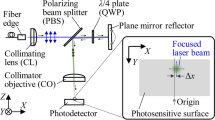Abstract
An optical mechanism proposed in this paper is composed of a movable part and a fixed part for the increment high-resolution optical displacement encoders. A parallel light source is set on the moving part and a double-concave lens, a specially designed optical grating and a phototransistor array receiver are set on the fixed part. The parallel light emitted from the movable part passes through the double-concave lens and the specially designed optical grating; it is then projected onto the phototransistor array receiver to indicate the displacement of the movable part. The relationship equation of the lens is developed to design an optical mechanism, which can enlarge the displacement so that it becomes observable. Based on the simulation results, three different radii in the curvature of the double-concave lens were proposed. The simulation results indicated that the optical mechanism with 50 times magnification could make the 10 nm movement intervals of a light source be about 500 nm movement intervals in the detecting surface. Furthermore, considering the limitation of the precision of existing tools, an experimental system with a 200 nm resolution was established to verify the possibility of the proposed structure. The experimental result indicates the possibility of using the proposed theorem to achieve the desired results.








Similar content being viewed by others
References
Durelli AJ, Parks VJ (1970) Moire analysis of strain. University of California, USA
Guild J (1960) Diffraction gratings as measuring scales. Oxford University Press, England
Hagiwara N, Suzuki Y, Murase H (1992) A method of improving the resolution and accuracy of rotary encoder using code compensation technique. IEEE Trans Instrum Meas 40(1). doi:10.1109/19.126640
Hane K, Endo T, Ito Y, Sasaki M (2001) A compact optical encoder with micromachine photodetector. J Opt A Pure Appl Opt 3:191–195. doi:10.1088/1464-4258/3/3/307
Hecht E (2002) Optics. Addison-Wesley Press, San Francisco
Hercher M, Wyntjes G (1989) Fine measurement with coarse scale. In: Proceedings of 5th International Precision Engineering Seminar and 4th Annual Meeting. Monterey, CA, pp 86–92
Nishimura T, Ishizuka K (1986) Laser Rotary Encoder, Motion: Official journal of the Electronic Motion Control Association, September/October, Reprint obtained from Canon
Stephens WF, Mark EP (1990) Interpolation apparatus, US Patent 4,949,289
Acknowledgments
This research was supported in part by the project of the National Science Council, Taiwan, under Grant 98-2221-E-033-046 and NSC 96-2622-E-033-006-CC3.
Author information
Authors and Affiliations
Corresponding author
Rights and permissions
About this article
Cite this article
Fan, YH., Chen, CE., Lou, LY. et al. Experiment and design of a high-resolution optical encoder. Microsyst Technol 19, 1775–1779 (2013). https://doi.org/10.1007/s00542-013-1815-y
Received:
Accepted:
Published:
Issue Date:
DOI: https://doi.org/10.1007/s00542-013-1815-y




